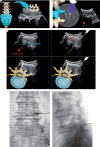Noninferiority of ultrasound-guided lumbar disc block versus fluoroscopy-controlled lumbar discography for diagnosis of discogenic low back pain
- PMID: 40696857
- PMCID: PMC12329494
- DOI: 10.5114/ait/203492
Noninferiority of ultrasound-guided lumbar disc block versus fluoroscopy-controlled lumbar discography for diagnosis of discogenic low back pain
Abstract
Introduction: Evaluation of ultrasound (US)-guided disc block used to diagnose discogenic pain, as described in case reports. The study aimed to ascertain the noninferiority of US-guided lumbar disc block to conventional discography in the diagnosis of discogenic low back pain (DLBP).
Material and methods: The reports of 418 patients undergoing lumbar fusion for DLBP were stratified into a US group receiving US-guided lumbar disc block and a control group receiving fluoroscopy (FL)-assistant discography via a propensity-score matched method in a 1 : 1 ratio. The primary endpoint was the confirmatory rate defined as the rate of clinical success following surgery measured by a numerical pain rating scale score ≤ 2 and an Oswestry Disability Index score ≤ 15 at the 1-month follow-up point. Secondary outcomes included needle insertions until contrast given, procedure time, radiation dosages and adverse events.
Results: The confirmatory rates for disc block and discography were 71.8% and 73.2% (difference = -1.3%, 95% confidence interval [CI]: -9.9%, 7.2%, P = 0.353). The lower bound of 95% CI did not cross the noninferiority margin of 10%. There were fewer needle insertions (median 2, IQR: 1-3 vs. 5, IQR: 4-6, P < 0.001), shorter procedure times (8.94 ± 2.28 vs. 16.13 ± 3.39 min, P < 0.001) and lower radiation dosage (1689.56 ± 898.54 vs. 8293.50 ± 1039.09 μGy m2 , P < 0.001) in the US group than the control group. No serious adverse events were observed.
Conclusions: US-guided lumbar disc block was not inferior to conventional discography as a diagnostic modality in the evaluation of DLBP being considered for surgery. Given that the sonographic method provided advantages in terms of facilitation of needle insertion, reduced procedure time, and attenuated radiation exposure, it might be an alternative option for surgery decision making.
Keywords: complication; disc block; discogenic low back pain; discography; radiation exposure; ultrasound.
Figures



Similar articles
-
Systematic review of lumbar discography as a diagnostic test for chronic low back pain.Pain Physician. 2009 May-Jun;12(3):541-59. Pain Physician. 2009. PMID: 19461822
-
Minimally invasive discectomy versus microdiscectomy/open discectomy for symptomatic lumbar disc herniation.Cochrane Database Syst Rev. 2014 Sep 4;2014(9):CD010328. doi: 10.1002/14651858.CD010328.pub2. Cochrane Database Syst Rev. 2014. PMID: 25184502 Free PMC article.
-
An update of the systematic appraisal of the accuracy and utility of lumbar discography in chronic low back pain.Pain Physician. 2013 Apr;16(2 Suppl):SE55-95. Pain Physician. 2013. PMID: 23615887
-
Ultrasound guidance for upper and lower limb blocks.Cochrane Database Syst Rev. 2015 Sep 11;2015(9):CD006459. doi: 10.1002/14651858.CD006459.pub3. Cochrane Database Syst Rev. 2015. PMID: 26361135 Free PMC article.
-
The correlation between the lumbar disc MRI high-intensity zone and discogenic low back pain: a systematic review and meta-analysis.J Orthop Surg Res. 2023 Oct 7;18(1):758. doi: 10.1186/s13018-023-04187-5. J Orthop Surg Res. 2023. PMID: 37805519 Free PMC article.
References
-
- GBD 2021 Low Back Pain Collaborators . Global, regional, and national burden of low back pain, 1990-2020, its attributable risk factors, and projections to 2050: a systematic analysis of the Global Burden of Disease Study 2021. Lancet Rheumatol 2023; 5: e316-e329. DOI: 10.1016/S2665-9913(23)00098-X. - DOI - PMC - PubMed
Publication types
MeSH terms
LinkOut - more resources
Full Text Sources
